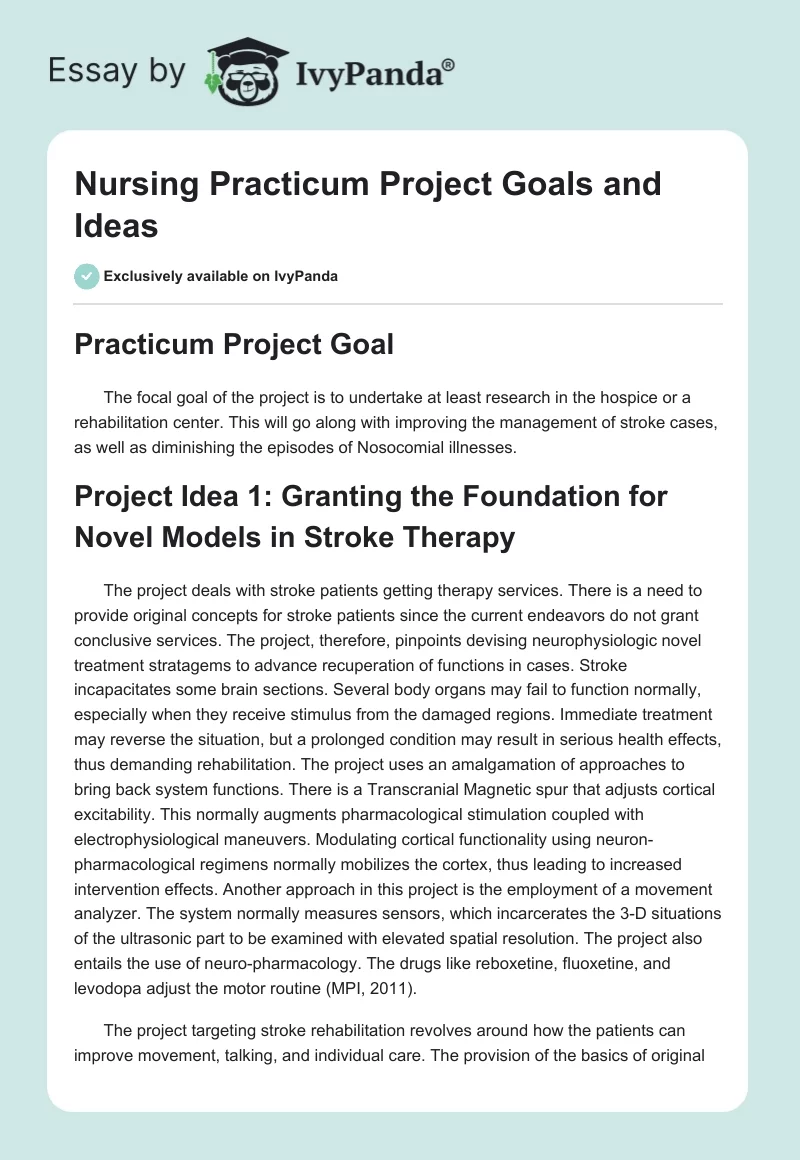Practicum Project Goal
The focal goal of the project is to undertake at least research in the hospice or a rehabilitation center. This will go along with improving the management of stroke cases, as well as diminishing the episodes of Nosocomial illnesses.
Project Idea 1: Granting the Foundation for Novel Models in Stroke Therapy
The project deals with stroke patients getting therapy services. There is a need to provide original concepts for stroke patients since the current endeavors do not grant conclusive services. The project, therefore, pinpoints devising neurophysiologic novel treatment stratagems to advance recuperation of functions in cases. Stroke incapacitates some brain sections. Several body organs may fail to function normally, especially when they receive stimulus from the damaged regions. Immediate treatment may reverse the situation, but a prolonged condition may result in serious health effects, thus demanding rehabilitation. The project uses an amalgamation of approaches to bring back system functions. There is a Transcranial Magnetic spur that adjusts cortical excitability. This normally augments pharmacological stimulation coupled with electrophysiological maneuvers. Modulating cortical functionality using neuron-pharmacological regimens normally mobilizes the cortex, thus leading to increased intervention effects. Another approach in this project is the employment of a movement analyzer. The system normally measures sensors, which incarcerates the 3-D situations of the ultrasonic part to be examined with elevated spatial resolution. The project also entails the use of neuro-pharmacology. The drugs like reboxetine, fluoxetine, and levodopa adjust the motor routine (MPI, 2011).
The project targeting stroke rehabilitation revolves around how the patients can improve movement, talking, and individual care. The provision of the basics of original concepts in stroke rehabilitation is crucial in ensuring that the patients get to do what they had been doing before the stroke complications. The main goal is thus to bring back normal functionality faster. It also aims at diminishing the cost of hospitalization since the patients convalesce sooner.
Project Idea 2: Management of Nosocomial Infections in the Hospital Among Nurses
Nosocomial illnesses normally originate from the hospital scenery. These infections cause several deaths to the nurses and other people in the hospital surrounding. Such infections normally occur due to elevated pervasiveness of pathogens and compromised hosts, as well as effective transmission mechanisms from the sick. Nosocomial is a critical area that the project would aid in discovering the minor details behind. Nurses stand a higher chance of contracting these infections, as do other medics. Some of the known pathogens notorious for causing infections to encompass Enterococcus spp, Escherichia coli, Staphylococcus aureus, and others (Irwin & Rippe, 2008). During the practicum, the student will assemble data about the infections using questionnaires and other interview schedules. This would provide information for gauging the prevalence of such infections in the hospital. The project would collect information about the presence of the pathogen in the hospital. This would involve some laboratory procedures to set apart among the organisms. The chain of spread is also covered under this project. The project would aid in devising universal precautionary measures and prevention strategies.
The project has several goals to attain in the course of practicum. It aims at establishing the predominance of nosocomial infections in the hospital. This will also entail the incidence rate. It also aims at discovering the prevalent microorganisms in the hospital and the state of the compromised hosts. Another goal is to discover the chain of spread. In addition, the project aims at discovering the best defensive measures and other prevention strategies, which may aid in decreasing the prevalence of Nosocomial contaminations among the people in the hospice setting.
References
Irwin, R. & Rippe, J. (2008). Irwin and Rippe’s intensive care medicine. Pensylvania, PA: Lippincott Williams & Wilkins.
Max Planck Institute (MPI). (2011). Neuromodulation & Neurorehabilitation. Web.


